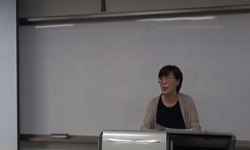This thesis examines the relation between ‘house’ and ‘women’ represented in gothic novel. Based on it, the relations and structures of various forces acting on the world around women can be identified. In gothic novel, for women ‘house’ a...
http://chineseinput.net/에서 pinyin(병음)방식으로 중국어를 변환할 수 있습니다.
변환된 중국어를 복사하여 사용하시면 됩니다.
- 中文 을 입력하시려면 zhongwen을 입력하시고 space를누르시면됩니다.
- 北京 을 입력하시려면 beijing을 입력하시고 space를 누르시면 됩니다.
https://www.riss.kr/link?id=T15899505
- 저자
-
발행사항
서울 : 숙명여자대학교 대학원, 2021
-
학위논문사항
학위논문(박사) -- 숙명여자대학교 대학원 , 영어영문학과 영문학전공 , 2021. 8
-
발행연도
2021
-
작성언어
한국어
- 주제어
-
발행국(도시)
서울
-
형태사항
149 ; 26 cm
-
일반주기명
지도교수: 박인찬
-
UCI식별코드
I804:11043-000000069937
- 소장기관
-
0
상세조회 -
0
다운로드
부가정보
다국어 초록 (Multilingual Abstract)
This thesis examines the relation between ‘house’ and ‘women’ represented in gothic novel. Based on it, the relations and structures of various forces acting on the world around women can be identified. In gothic novel, for women ‘house’ appears as ambivalent meaning of imprisonment and escape. In the space of imprisonment women are under the paradoxical circumstances from where they want escape but have to conform the condition of oppression in order to gain protection and stability. The lives and experience of women in gothic novel are not described metaphorically and indirectly, but appear to be as distressing and strange state. Women feel a sense of separation and ‘uncanniness’ in where the ‘house’ should be protective and stable place. In this thesis I attempt to show the meaning of female experience and reality which presented through the relation between women and house in gothic novel, by considering Henry James’ The Turn of the Screw, Shirley Jackson’s The Haunting of Hill House and Alison Bechdel’s Fun Home.
In the first chapter, I argue women’s placement and meaning of existence in patriarchal society represented in The Turn of the Screw. Women can be considered as the drifting existence which share the characteristics of the governess and the ghosts. Moreover, I examine the novel’s ‘narrative of frame’ in relation with the objectification of women and the meaning of the presence of women trapped in domestic space under the patriarchal society. In the second chapter, I read the social pressure and repression on women by focusing on the relationship between Eleanor Vance, the main female character, and Hill House in The Haunting of Hill House. At the end of the novel, Eleanor's choice represents the subversive possibility of society's power to confine and oppress women. Though Eleanor’s ending is self-destructive, she pursues her desires by her own will and rejects social coercion. In the third chapter, I consider Fun Home as an alternative to the new possibilities in the relationship between women and space in gothic novel. In Fun Home, Bechdel escapes from her father who oppresses and manipulates her, and his home. Furthermore, she dissembles the house and recreates the house of her own by constructing archive about father and inscribing her personal story on canonical modernism literature. With her own perspective as a female / lesbian / graphic narrative artist, she creates whole new literary space. Bechdel's attempt is significant, for it acts as an subversive force on the power structure of male / heterosexual world / canonical writer.
In addition, examining the relation between women and house in gothic novel shows the changes in the form and meaning of space. While the space in James' The Turn of Screw reflects the conventional elements of British female Gothic novels, the spaces in Jackson and Bechdel’s novel show changes in the environment of modern American society, along with the possibility of expanding the category of gothic novels’ content and form.
Examining the relationship between home and women presented in gothic novels is meaningful to focus on the women's experiences and reality reflected in literature. However, the sense of ‘uncanny' in gothic spaces is also important, for it can serve as a starting point for literary research into not only women but also those who are seen but considered as not-be-seen.
국문 초록 (Abstract)
본 논문에서는 고딕소설에 나타나는 ‘집’과 여성의 관계를 살펴본다. 이를 통해 여성을 둘러싼 세계에 작용하는 다양한 힘의 관계와 구조를 살펴본다. 고딕소설에서 여성에게 ‘집’은 ...
본 논문에서는 고딕소설에 나타나는 ‘집’과 여성의 관계를 살펴본다. 이를 통해 여성을 둘러싼 세계에 작용하는 다양한 힘의 관계와 구조를 살펴본다. 고딕소설에서 여성에게 ‘집’은 감금과 탈출의 양가적인 의미로 나타난다. 이러한 억압과 감금의 공간에서 여성은 탈출하기를 원하면서도 보호와 안정을 얻기 위해서 억압과 감금의 조건에 순응해야하는 모순적인 상황에 처한다. 고딕소설에 나타나는 여성의 삶과 경험은 우회적이고 상징적으로 나타나는 것이 아니라 고통스럽고 기이한 상태 그대로 드러난다. 여성은 보호와 안정의 공간이어야 할 집에서 오히려 불안하고 두려운 상황에 처하게 되는 괴리감과 낯설음을 느낀다. 본 논문에서는 고딕소설에서 재현되는 여성과 공간의 관계를 통해 나타나는 여성의 경험과 현실에 주목하여 그 의미를 고찰해보고자 한다.
1장에서는『나사의 회전』에 나타나는 가부장 사회에서 적법한 자리를 갖지 못하고 가정교사와 유령처럼 부유하는 여성의 모습과 존재 의미에 대해서 분석한다. 또한 소설의 액자식 구성을 여성의 대상화와 가부장 사회에서 가정공간에 갇힌 여성의 존재 의미와 연결해서 살펴본다.
2장에서는 잭슨의『힐 하우스의 유령』의 엘리너와 힐 하우스의 관계를 통해서 여성에게 가해지는 사회적 압박과 억압에 대해서 고찰해본다. 엘리너를 압박하고 사람들 간의 관계를 단절시키는 힐 하우스의 구조와 초자연적인 힘은 소설의 배경이 되는 1950년대의 보수적인 미국사회에서 여성에게 작용한 가부장 사회의 억압으로 연결시켜 볼 수 있다. 힐 하우스에서 고통 받는 엘리너는 이상적 여성상으로 제시된 가정에 제한되는 삶을 강요당하는 당대 여성의 모습을 반영한다. 엘리너의 자기파괴적인 결말은 엘리너가 스스로의 선택으로 자신의 욕망을 추구하고 사회의 강요를 거부한다는 점에서 저항적 의미를 갖는다.
3장에서 살펴볼『펀 홈』은 고딕소설에 나타나는 여성과 공간의 관계에서의 새로운 가능성의 대안을 제시하는 작품으로 볼 수 있다. 자신을 통제하고 억압하는 아버지의 집에서 탈출한 벡델은 이를 해체하고 재구성하여 자신만의 새로운 공간을 만들어 낸다. 아버지에 대한 기억과 관련 자료들을 모아서 이를 그래픽 내러티브 형식을 통해 시각화하여 『펀 홈』이라는 아카이브를 구성한다. 또한 벡델은 아버지와 자신을 연결해주는 요소인 문학을 차용하여 정전으로 불리는 문학작품에 사적인 경험과 기억의 조각들로 채워넣고 여성/레즈비언/예술가로서의 자신의 시각을 중심으로『펀 홈』이라는 새로운 문학적 공간을 만들어낸다. 벡델의 이러한 시도는 기존의 남성/주류작가/이성애 중심으로 구성되어 있던 공간에의 권력 구조에 전복적인 힘으로 작용한다.
여성과 고딕적 공간의 관계의 의미와 그 변화를 살펴보는 과정에서는 또한 고딕소설에서 구현되는 공간의 변화도 함께 나타난다.『나사의 회전』에서 나타나는 공간이 영국 여성 고딕소설에서 비롯되는 전형적인 요소를 반영하고 있다면 『힐 하우스의 유령』과 『펀 홈』에서는 이를 미국 현대 사회의 환경에 적용하여 변화된 모습을 보여주며 내용적으로도 형식적으로도 고딕소설의 범주의 확장 가능성을 찾아볼 수 있다.
고딕소설에 재현되는 집과 여성의 관계를 살펴보는 것은 문학에 반영되어 있는 여성 삶의 경험에 집중하여 여성의 현실을 고찰해보는 것에 의의가 있다. 그리고 고딕적 공간에서 나타나는 ‘익숙함 속의 낯설음’의 감각은 여성뿐만 아니라 보이지만 보이지 않는 존재로 치부되는 존재들에 대한 문학적 연구의 시작점이 될 수 있다는 것에서도 중요한 의미를 갖는다.
목차 (Table of Contents)
- Ⅰ. 서론 = 1
- Ⅱ. 본론 = 19
- 1. 존재하되 존재하지 않는 존재로서의 여성: 『나사의 회전』 = 19
- 1) 로맨스의 성: 블라이 = 21
- Ⅰ. 서론 = 1
- Ⅱ. 본론 = 19
- 1. 존재하되 존재하지 않는 존재로서의 여성: 『나사의 회전』 = 19
- 1) 로맨스의 성: 블라이 = 21
- 2) 부유하는 존재로서의 여성: 가정교사와 유령 = 31
- 3) 여성의 공간: 가정공간과 여성의 위치 = 44
- 2. 집에서 집을 잃다: 『힐 하우스의 유령』 = 55
- 1) 그 만의 집: 힐 하우스 = 57
- 2) 즐거운 나의 집이라는 허상: 엘리너와 집의 의미 = 68
- 3) “엘리너가 집에 올 수 있게 도와줘”: 어머니, 아이, 집 = 80
- 3. 아버지의 집에서 나의 집으로: 『펀 홈』 = 94
- 1) 고딕적 공간으로서의 펀 홈 = 96
- 2) 기억의 아카이브로서의 펀 홈 = 104
- 3) 문학적 변주와 전복의 공간으로서의 펀 홈 = 115
- Ⅲ. 결론 = 134
- Ⅳ. 인용문헌 = 140
- ABSTRACT = 147













